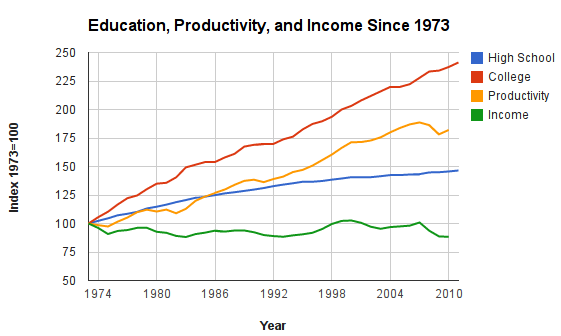Regular readers know by now that I am a big proponent of the idea that poor people are poor because they do not have enough money. This radical theory causes me to support such ideas as distributing enough money to poor people so that they are no longer poor. It seems simple — and is quite affordable to boot — but it does not seem to gain any traction. We know the right-wing wont go for it, but even so-called liberals seem squeamish about it.
In its place, liberals pound education. I know I talk about this quite a bit, but rightly so: this is the conventional wisdom of your average liberal. More education, more education, more education. Now look, education is great. It is both an intrinsic and instrumental good. And it also tends to improve overall productivity. But that does not tell us anything about how productivity gains will be distributed or whether there will be more or less non-poverty economic positions for people to occupy. Consider the last 40 years:

I have become so tired of hearing about education that I have hopefully made the graph to end all graphs on this. In this graph we have the percentage of the population with high school degrees, the percentage of the population with college degrees, GDP per capita, and the average market income of the bottom 90% of income earners. They are all indexed to 100 at 1973. I realize it is a bit strange to index percentages of the population alongside levels, but I think it works here.
So take a look. Since 1973, the share of the population with a college degree has gone up from 12.6% to 30.4%, and the share with high school degrees has gone up from 59.8% to 87.6%. And it sure does show in productivity gains: since 1973, GDP per capita has gone up 82%. Meanwhile market incomes for the bottom 90% have completely stagnated. That green line, according to the education parrots, should be rising along with the others. Instead, it is completely flat, and in fact dips below the 1973 level in all but three years.
How does poverty fare in this time period? I didn’t graph it to keep things simple, but the official poverty rate (which is basically market income plus Social Security) has never been lower than it was in 1973. It was 11.1% percent then; it was 15% in 2011. To reiterate: I am a big fan of education, and I think it’s really great. But in the face of the last 40 years, you just cannot seriously advocate more and more education as the solution to what is clearly a distributive problem.